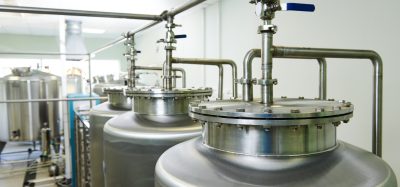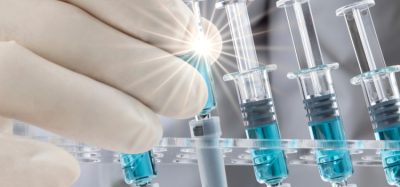Monitoring and controlling drug products and manufacturing processes with NIRS
Posted: 24 February 2017 | Dave Elder (David P Elder Constultancy) | No comments yet
Near-infrared spectroscopy (NIRS) is a rapid and non-destructive analytical technique that is important in analysing or profiling both solid and liquid dosage forms, as well as biotechnological products…


The advent of Quality by Design (QbD)1 has seen its use increase significantly, as it can be used to monitor and profile processes during development, as well as in production2. In general, NIRS methods that are intended for the release of active pharmaceutical ingredient (API) or drug product should be developed and validated in conjunction with the existing reference methods3. However, for some NIRS procedures it may be impractical to cross-reference traditional reference methods; that is, dynamic process monitoring of a powder or compression blend for homogeneity.
Regulatory perspective
The United States Food and Drug Administration (FDA) has published new draft guidance on the introduction of emerging technologies (including testing), with the objectives of modernising the manufacturing base within the pharmaceutical industry4,5. The FDA’s guidance on process validation6 also supports and encourages process improvements and continuing innovation. The agency has indicated that modernising the manufacturing base needs to be supported by an integrated approach to product and process understanding underpinned by real-time process analytical technology (PAT), enabling better understanding, monitoring and process control7. The European Union’s regulatory approach has been broadly similar.
API applications
NIRS has been used to assess polymorphism in drug substances8 and characterise hydrated and anhydrous forms of APIs9. It also proves extremely useful in monitoring and controlling residual water during the drying process of API manufacture. Zhou et al.10 previously employed NIRS for such means, using Karl Fisher titration as the reference technique. NIRS calibration models using partial least squares (PLS) regression were developed based on samples from five different drug substance batches with varying levels of water and the method demonstrated a standard error of prediction (SEP) of 0.42% (w/w).
Principal component analysis (PCA) and peak ratios can be used to distinguish between ‘unbound’ surface water and water that was incorporated into the crystal lattice of the drug substance, i.e., ‘bound’ water. These differences might then be used to ensure that the drying process has preferentially removed unbound water without affecting bound water, thus confirming that the desired hydrate form of the API is routinely produced.
Input materials
NIRS has shown promise in assessing the water content of different excipients11,12 and has led to the identification of a variety of types of polyvinylpyrrolidone13, microcrystalline cellulose14 and lactose monohydrate15. The technique has also been employed to characterise the effect of particle size on compactability for various different grades of hypromelose16. Similarly, Storz and Steffens17 assessed the impact of specific surface area of colloidal silicon dioxide.
Other interesting applications of NIRS have included the identification of three different PVC film-formers using PLS18 and the measurement of the thickness of PVC-based films used in blister packs19. The validation assessed the specificity, linearity, accuracy (99.6%), precision (<0.6% RSD), limit of quantification (41 micron) and robustness of the method.
Tablet blends
Blending is a critical stage in the production process of solid oral dosage forms, particularly for highly potent, low-strength drug products20,21. Non-invasive monitoring of powder blend uniformity using NIRS has been extensively reported and calibration-free methods have been developed based on the mean spectral residual standard deviation (RSD) as a function of time. This involves the convergence of the NIR spectra towards an anticipated endpoint, or homogenous blend, which is based on a predefined, statically based endpoint, i.e., ≤ 1% RSD22,23. The principal benefits of this approach are that there are no requirements for any pre-existing data. Qualitative determinations can be made with respect to the homogeneity of the blend; however, quantitative measurements will still require off-line testing24. This, in turn, can be addressed using a limited number of off-line samples to develop a NIRS model that can be used to quantitatively determine the content, in addition to the homogeneity24,25.
Tablet compression
Content uniformity of a drug product is defined by all of the major pharmacopoeias and is a specification test for the release testing of solid oral dosage forms20,21. NIRS in both the reflectance and transmittance modes has been used for content uniformity testing24. It has also been utilised for the real-time monitoring of tablet content uniformity using partial least squares (PLS) modelling26. Interestingly, by adopting multivariate methodologies, such as PLS, the manufacturer can monitor and control both the API and excipients27. This is critically important as for certain dosage forms, such as controlled-release products28, the excipients are often as vital as the drug substance itself in controlling the performance of the resultant drug product.
NIRS assays for drug product release purposes have also been extensively evaluated24,26,27,29 and NIRS methods for residual water in drug products, or during the drug product manufacturing processes, have been widely reported30,31.
Tablet film coating
The coating of solid oral dosage forms such as tablets is of significant importance within the pharmaceutical industry. Conventionally, film coat thickness is monitored and controlled utilising the average weight gain of the tablet cores, e.g., ca. 3% w/w target for non-functional film coats. This typically requires sampling and off-line or at-line weighing, which is an intrinsically inefficient process. Alternatively, reflectance mode NIRS can be used as an off-line32, on-line33, or in-line34,35 PAT tool. This is achieved by assessing the reduction in the absorbance signal of the tablet cores and, in parallel, observing the increase in the absorbance signal of the film coating constituents.
In-line NIRS monitoring has been used for fluid bed34 and pan coating35 processes. In the reflectance mode, the technique can monitor and control film coating thicknesses faster and more cheaply than either imaging36 or scanning electron microscopy. The method produces excellent outcomes compared with the classical weight gain approaches24. NIRS has been used in conjunction with multi-variate modelling to monitor tablet coating37,38.
Tablet quality control
To improve the safety of pharmaceutical products, a NIRS method was used to check the identity all packaged tablets at full line speed, making a throughput of 12,000 tablets per minute possible39. This approach has also been extensively used to perform an identity check on outgoing clinical trial materials40,41,42. However, packaged clinical trial supplies are more complex than commercially packaged drug products, as some of the packs contain placebo drugs, some are combinations of placebo and active medicines, and some contain only active products.
NIRS method validation
There are numerous international guidance documents on the validation of NIRS methods. The European Medicines Agency guidance3 has four main focus areas: general requirements; qualitative and quantitative procedures; and lifecycle and post-approval issues. The FDA’s guidance is broadly similar and additionally covers external validation, implementing and maintaining NIRS procedures, and post-approval changes43. The USP covers validation parameters, ongoing method evaluation and method transfer44.
The sample population for any NIRS method should address all possible variation that is likely to be encountered during normal production. This includes: sample age; variation in temperature; process variation; quantitative and qualitative variations in the sample matrix, e.g., formulation or excipient grade/vendor or particle size changes; variations in solvent or water content; variation in material suppliers (both APIs and excipients); and lastly, concentration of the analyte. However, whatever the intended use, the NIRS method should be able to both accept and reject samples that are outside the pre-defined scope, such as by being compositionally different or outside the method’s validated range3.
The development, validation and application of quantitative NIRS methods is not straightforward compared with other classical methodologies, as chemometrics play a fundamental role in the data acquisition process. Hence, there are several unique challenges, including the need to compile representative samples and reference libraries before developing and validating the predictive models for use with multivariate data45,46,47.
Qualitative NIRS methods require internal validation of the spectral reference library and external validation using an independent validation set and should be validated for specificity and robustness (as a minimum requirement)3. Quantitative NIRS methods should be validated as per ICH Q2(R1)48 for specificity, linearity, range, accuracy and precision, robustness, and limits of detection and quantification. In addition, since quantitative NIRS methods are cross-validated against the existing reference method, a statistically derived acceptance criterion (SEP) is used as a measure of the NIRS model’s ability to correctly predict the appropriate quantitative outcome.
There are three main approaches to NIRS method validation49, with the first being the descriptive method that compares derived statistical factors versus pre-defined acceptance criteria. This appears to be the preferred approach to NIRS validation50,51,52. In addition, some research groups have also utilised this method for at least one of the ICH Q2(R1)48 method validation parameters (typically, precision or linearity). The linearity approach statistically compares the predicted results from the NIRS method with the existing reference method and typically uses a determination coefficient or the correlation coefficient. Values close to one are deemed equivalent and in those cases the NIRS and the reference method can be used interchangeably. However, this means of validation has been criticised for not adequately defining comparability or exchangeability53.
The second approach is called the ‘difference approach’. This uses a hypothesis-based means of assessing whether the observed results are statistically different from the existing reference method, using a t-test (or similar) to assess the intrinsic accuracy of the NIRS method (this is alternatively termed a ‘trueness assessment’). Many researchers conclude that when the results from the hypothesis test are insignificant, then ‘absence of the effect can be considered true’. However, absence of proof of an effect is not proof of its absence49. On this basis, quantitative NIRS methods are sometimes viewed as satisfactory, i.e., displaying an absence of bias, whereas, during subsequent use, their performances can be potentially unacceptable, i.e., not ‘fit for purpose’49,53,54,55.
De Bleye and Chevez49 observed that there are “equivalence” approaches that address this flawed approach, but they are rarely used in NIRS method validation54,55,56. The third approach is based on tolerance intervals (or prediction intervals), which can be used to assess the NIRS methods’ fitness for use. This draws on the idea of defining an acceptable accuracy profile, i.e., ±5% for assay methods and ±15% for content uniformity methods. De Bleye and Chevez49 concluded that using normal chemometric ‘figures of merit’ (i.e., root-mean-squared-error; RMSE) or the difference approach (comparing the relative bias of the two methodologies) does not result in NIRS methods that are ‘fit for purpose’ with respect to quality, accuracy or reliability.
Conclusion
NIRS has been extensively used to monitor and control component parts of drug products, including APIs, excipients and packaging materials, as well as providing real-time assessment and control of the entire manufacturing process as part of a PAT approach. Regulators support an increased usage of these PAT tools; however, NIRS is often seen as complementary to the existing release methodology, rather than as an alternative to these methods. For instance, it would seem logical to replace classical sampling/testing of individual excipient containers with at-line NIRS identity testing (no sampling is required as the NIRS method can assay remotely). However, Annex 8 of the EU GMP guideline57 states that “the identity of a complete batch of starting materials can normally only be ensured if individual samples are taken from all the containers and an identity test performed on each sample”. However, the EMA indicates that there are no constraints on performing additional testing and the use of NIRS to confirm container identity can provide useful information.
Biography


References
- ICH Q8(R2). Pharmaceutical development. Current Step 4 version dated August 2009
- Roggo Y, Chalus P, Maurer L, Lema-Martinez C, Edmund A, Jent N, et al Pharm. Biomed. Anal. 2007; 44(3), 683-700
- Guideline on the use of near infrared spectroscopy (NIRS) by the pharmaceutical industry and the data requirements for new submissions and variations. EMA/CHMP/CVMP/QWP/17760/2009 Rev 2, 20 January 2012
- Pharmaceutical GMPs for the 21st century: A risk based approach. Food and Drug Administration, September 2004. Available from: http://www.fda.gov/downloads/Drugs/DevelopmentApprovalProcess/Manufacturing/QuestionsandAnswersonCurrentGoodManufacturingPracticescGMPforDrugs/UCM176374.pdf
- Advancement of emerging technology applications to modernize the pharmaceutical manufacturing base. Guidance for Industry. Food and Drug Administration, Center for Drug Evaluation and Research (CDER), December 2015
- Process Validation: General Principles and Practices. Guidance for Industry. Food and Drug Administration, Center for Drug Evaluation and Research (CDER), Center for Biologics Evaluation and Research (CBER) Center for Veterinary Medicine (CVM), January 2011. Available from: http://www.fda.gov/downloads/Drugs/…/Guidances/UCM070336.pdf
- FDA, 2004b. PAT — A Framework for Innovative Pharmaceutical Development, Manufacturing, and Quality Assurance. Food and Drug Administration, Center for Drug Evaluation and Research (CDER), Center for Veterinary Medicine (CVM) Office of Regulatory Affairs (ORA), September 2004. Available from: http://www.fda.gov/downloads/Drugs/…/Guidances/ucm070305.pdf
- McArdle P, Gilligan K, Cunningham D, Ryder A. Determination of the Polymorphic Forms of Bicifadine Hydrochloride by Differential Scanning Calorimetry–Thermogravimetric Analysis, X-ray Powder Diffraction, Attenuated Total Reflectance–Infrared Spectroscopy, and Attenuated Total Reflectance–Near-Infrared Spectroscopy. Appl. Spectrosc. 2005; 59(11), 1365-1371
- Hugerth A, Brisander M, Wrange U, Kritokos M, Norrlind B. Svensson M, Bisrat M, Ostelius J. Physical Characterization of Anhydrous and Hydrous Forms of the Hydrochloride Salt of BVT.5182 A Novel 5-HT6 Receptor Antagonist. Drug Dev. Ind. Pharm. 2006; 32(2), 185-196
- Zhou GX, Ge Z, Dorwart J, Izzo B, Kukura J, Bicker G, Wyvratt J. Determination and differentiation of surface and bound water in drug substances by near infrared spectroscopy. J. Pharm. Sci. 2003; 92, 1058-1065
- Beyerand J, Steffens KJ. Calibration models for determination of water content in pharmaceutical excipients using near-infrared spectroscopy (NIRS). Ind. 2003; 65(2), 186-192
- Airaksinen S, Karjalainen M, Shevchenko A., Westermarck S, Leppanen E, Rantenen J, Yliuruusi J. Role of water in the physical stability of solid dosage formulations. Pharm. Sci. 2005; 94(10), 2147-2165
- Kreft K, Kozamernik B, Urleb U. Qualitative determination of polyvinylpyrrolidone type by near-infrared spectrometry. J. Pharm. 1999; 177(1), 1-6
- Ebube NK, Thosar SS, Roberts RA, Kemper MS, Rubinovitz R, Martin DL, Reier GE, Wheatley TA, Shukla AJ. Application of near-infrared spectroscopy for nondestructive analysis of Avicel powders and tablets. Dev. Technol. 1999; 4(1), 19-26
- Plugge W, Van der Vlies C. Near-infrared spectroscopy as a tool to improve quality. Pharm. Biomed. Anal. 1996; 14(8), 891-898
- Gustafsson C, Nystrom C, Lennholm H, Bonferoni MC, Caramella CM. Characteristics of hydroxypropyl methylcellulose influencing compactibility and prediction of particle and tablet properties by infrared spectroscopy. J. Pharm. Sci. 2003; 92(3), 494-504
- Storz E, Steffens KJ. 2002. Determination of the specific surface area of colloidal silicon dioxide with near-infrared spectroscopy. Pharm. Ind. 2002; 64(4), 398-402
- Laasonen M, Rantanen J, Harmia-Pulkkinen T, Micheals E, Hiltunen R, Räsänen M, Vuorela H. Near infrared reflectance spectroscopy for the fast identification of PVC-based films. Analyst. 2001; 126(7), 1122-1128
- Laasonen M, Harmia-Pulkkinen T, Simard C, Räsänen M, Vuorela H. Determination of the thickness of plastic sheets used in blister packaging by near infrared spectroscopy: development and validation of the method. Eur. J. Pharm. Sci. 2004; 21(4), 493-500
- Berman J, Blanchard JA. Blend uniformity and unit dose sampling, Drug Dev. Ind. Pharm. 1995; 21, 1257-1283
- Muzzio FJ, Robinson P, Wightman C, Brone D. Sampling practices in powder blending. J. Pharm. 1997; 155, 153-178
- Hailey PA, Doherty P, Tapsell P, Oliver T, Aldridge PK. Automated system for the on-line monitoring of a powder blending process using near infra-red spectroscopy. Part I. system development and control. J Pharm Biomed Anal. 1996; 14, 551-559
- Blanco M, Gozález Bañó R, Bertran E. Monitoring powder blending in pharmaceutical processes by use of near infrared spectroscopy. Talanta. 2002; 56, 203-212
- Moes JJ, Ruijken MM, Gout E, Frijlink HW, Ugwoke MI. Application of process analytical technology in tablet process development using NIR spectroscopy: Blend uniformity, content uniformity and coating thickness measurements. Int. J. Pharm. 2008; 357, 108-118
- Bertsson O, Danielsson L-G, Lagerholm B, Folestad S. Quantitative in-line monitoring of powder blending by near-infrared reflection spectroscopy. Powder Technol. 2002; 123, 185-193
- Skibsted ETS, Westerhuis JA, Smilde AK, Witte DT. Examples of NIR based real time release in tablet manufacturing, J. Pharm. Biomed. Anal. 2007; 43, 1297-1305
- Karande AD, Heng PWS, Liew CV. In-line quantification of micronized drug and excipients in tablets by near infrared (NIR) spectroscopy: Real time monitoring of tableting process. Int. J. Pharm. 2010; 396, 63-74
- SUPAC MR, 1999. Modified Release Solid Oral Dosage Forms Scale-Up and Post approval Changes: Chemistry, Manufacturing, and Controls; In Vitro Dissolution Testing and In Vivo Bioequivalence Documentation. U.S. Department of Health and Human Services Food and Drug Administration Center for Drug Evaluation and Research (CDER) September 1997
- Blanco M, Cueva-Mastanza R, et al. Controlling individual steps in the production process of paracetamol tablets by use of NIR spectroscopy. J. Pharm. Biomed. Anal. 2010; 51, 797-804
- Mantanus J, Ziemons E, et al. Moisture content determination of pharmaceutical pellets by near infrared spectroscopy: Method development and validation. Anal. Chimica. Acta. 2009; 642, 186-192
- Peinado A, Hammond J, et al. Development, validation and transfer of a near infrared method to determine in-line the end point of a fluidised drying process for commercial production batches of an approved oral solid dose pharmaceutical product. Pharm. Biomed. Anal. 2011; 54, 13-20
- Kirsch JD, Drennan JK. Determination of the film-coated tablet parameters by near-infrared spectroscopy. J. Pharm. Biomed. Anal. 1995; 13, 1273-1281
- Kirsch JD, Drennan JK. Near-infrared spectroscopy monitoring of the film coating process. Pharm. Res. 1996; 13, 234-237
- Andersson M, Folestad S, Gottfies J, Johansson MO, Josefson M, Wahlund KG. Quantitative analysis of film coating in a fluidized bed process by in-line NIR spectrometry and multivariate batch calibration. Anal. Chem. 2000; 72, 2099-2108
- Pérez-Ramos JD, Findlay WP, Peck G, Morris KR. Quantitative analysis of film coating in a pan coater based on in-line sensor measurements. AAPS PharmSciTech. 2005; 6, E127-E136
- Andersson M, Holmquist B, Lindquist JO, Nilsson O, Wahlund KG. Analysis of film coating thickness and surface area of pharmaceutical pellets using fluorescence microscopy and image analysis. J. Pharm. Biomed. Anal. 2000; 20, 325-339
- Gendre C, Genty M, Boiret M, Julien M, Menier L, Lecoq O, Baron M, Chamiade P, Pean JM. Development of a process analytical technology (PAT) for in-line monitoring of film thickness and mass of coating materials during a pan coating operation. Eur. J. Pharm. Sci. 2011; 43, 244-250
- Gendre C, Genty M, Chamiade P, Pean JM. Real-time predictions of drug release and end point detection of a coating operation by in-line near infrared measurements, Int. J. Pharm. 2011; 421, 237-243
- Herkert T, Prinz H, Kovar KA. One hundred percent online identity check of pharmaceutical products by near-infrared spectroscopy on the packaging line. Eur. J. Pharm. Biopharm. 2001; 51, 9-16
- Dempster MA, Jones JA, Last IR, MacDonald BF, Prebble KA. Near-infrared methods for the identification of tablets in clinical trial supplies. J. Pharm. Biomed. Anal. 1993; 11; 1087-1092
- Tso C, Ritchie GE, Gehrelein L, Ciuczak EW. A general test method for the development, validation, and routine use of disposable near infrared libraries. Near Infrared Spectrosc. 2001; 9(3), 165-184
- De Maesschalk R, Van den Kerkhof T. Implementation of a simple semi-quantitative near-infrared method for the classification of clinical trial tablets. Pharm. Biomed. Anal. 2005; 37(1), 109-114
- FDA, 2015. Development and submission of near infrared analytical procedures, Guidance for Industry, US Department of Health and Human Services, Food and Drug Administration, Center for Drug Evaluation and Research (CDER), March 2015
- USP 38, 2015. General chapter <1119> Near Infrared Spectroscopy, 1215-1221
- ASTM (American Society for testing materials). Standard practices for infrared multivariate quantitative analysis. 2005; E 1665-05
- Forina M, Lanteri S, et al. Multivariate calibration. J. Chromatogr. A. 2007; 1158, 61-93
- Rajalahti T, Kvalheim OM. Multivariate data analysis in pharmaceutics: A review. J.Pharm. 2011; 417, 280-290
- ICH Q2(R1), 2005. Validation of Analytical Procedures: Text and Methodology. Current Step 4 version Parent Guideline dated 27 October 1994 (Complementary Guideline on Methodology dated 6 November 1996 incorporated in November 2005)
- De Bleye C, Chavez PF. Critical review of near-infrared spectroscopic validations in pharmaceutical applications. J. Pharm. Biomed. Anal. 2012; 69: 125-132
- Ito M, Suzuki T. Development of a method for non-destructive NIR transmittance spectroscopic analysis of acetaminophen and caffeine anhydrate in intact bilayer tablets. J. Pharm. Biomed. Anal. 2010; 53: 396-402
- Li W, Xing L, et al. Application of near-infrared spectroscopy for rapid analysis of intermediates of tanreqing injection. J. Pharm. Biomed. Anal. 2010; 53, 350-358
- Corredor CC, Bu D. Comparison of near-infrared and microwave resonance sensors for at-line moisture determination in powders and tablets. Chim. Acta. 2011; 696, 84-93
- Rozet E, Ceccato A, et al. Analysis of recent pharmaceutical regulatory documents on analytical method validation. J. Chromatogr. A. 2007; 1158, 111-125
- Bouabidi A, Rozet E, et al. Critical analysis of several analytical method validation strategies in the framework of the fit for purpose concept. J. Chromatogr. A. 2010; 1217, 3180-3192
- Chatfield M, Borman PJ. Acceptance criteria for method equivalency assessments. Anal. Chem. 81, 9841-9848
- Nethercote P, Borman P, Bennett T, Martin G, McGregor P. QbD for Better Method Validation and Transfer. Pharma Manufact., April 2010, 37-49
- EU GMP guide annexes: Supplementary requirements: Annex 8: Sampling of starting and packaging materials: Use of near-infrared (NIR) technology for container-wise identity testing. Available from: http://www.gmp-compliance.org/elements/PDF/2014-05-21_GMP-Question-and-Answer-Guide.pdf









